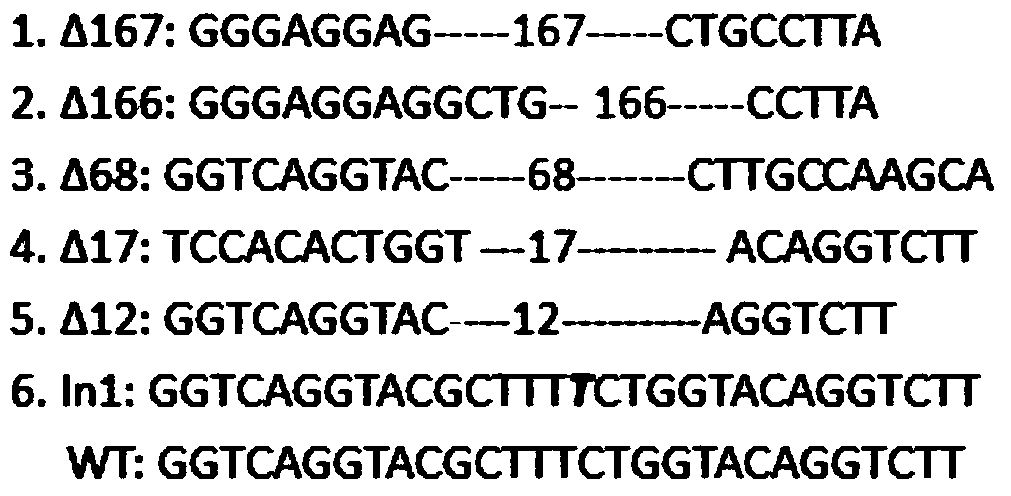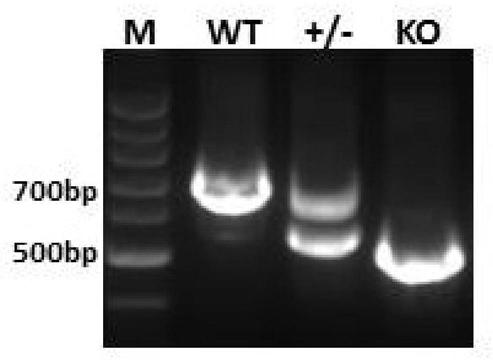Kit and method for constructing ApoC2 gene knockout hamster model
A technology of gene knockout and kit, which is applied in the field of disease animal models and its preparation, can solve the problem that mouse models cannot well simulate human HTG-related AS disease conditions, and achieve low lethality, high efficiency, and simple operation Effect
- Summary
- Abstract
- Description
- Claims
- Application Information
AI Technical Summary
Problems solved by technology
Method used
Image
Examples
Embodiment 1
[0058] The kit for constructing the ApoC2 gene knockout hamster model includes sgRNA and cas9mRNA, and the sgRNA is obtained by PCR amplification and in vitro transcription of the artificial sequences shown in SEQ ID NO:2 and SEQ ID NO:3.
[0059] The preparation steps of the sgRNA are:
[0060] The artificial sequences shown in SEQ ID NO:2 and SEQ ID NO:3 are used as primers and templates for PCR amplification. The method of PCR amplification is: carry out in a 50 μl system, and the reaction conditions are 98°C, 30s; 98°C, 10s, 56°C, 30s, 72°C, 15s, a total of 35 cycles; 72°C for 10min. The PCR product was subjected to agarose gel electrophoresis, and a 124bp DNA band was recovered with a gel recovery kit (TAKARA kit), and then treated with proteinase K for 30 minutes to remove as much as possible the RNase in the sample, and then extracted with phenol-chloroform , ethanol precipitation to obtain the DNA template of the purified sgRNA. The template was transcribed in vitro ...
Embodiment 2
[0065] In this example, the wild-type hamster purchased from Beijing Weitong Lihua Experimental Animal Technology Co., Ltd. is taken as an example to illustrate the method for constructing an ApoC2 gene knockout hamster model using the kit in Example 1. The experimental plan and process of the preparation and analysis of the hamster model in this example have passed the ethical review of experimental animals by the Ethics Committee.
[0066] The wild-type hamsters were raised according to clean-grade standards. Keep the humidity at 50-60% and the temperature at 22-24°C. The photoperiod is light from 7:00-19:00 and dark from 19:00-7:00.
[0067] The concrete method of preparing hamster model with wild-type hamster comprises the following steps:
[0068] Step 1, determine the ApoC2 gene information (GeneID: 101839353) in the database in NCBI (National Center for Biotechnology Information, American National Center for Biotechnology Information), design the hamster ApoC2 gene-sp...
test example 1
[0077] After the F0 generation hamsters were born one week old, the genomic DNA extracted from the toe tissue was collected, and the target fragment was amplified by PCR. The upstream primer was 5'-GGCATTACTCGCCCTTTAGC-3'(SEQ ID NO:4), and the downstream primer was 5'-CCGCAGGTCACAGACAACAT-3'(SEQ ID NO:5). The specific band was detected by electrophoresis after PCR and then sent for sequencing. Sequence and chromatograms to determine the mutation position.
[0078]Further sequence verification of the mutated hamster: link the PCR product to the T vector, transform it into competent cells, inoculate it on the LB medium plate with ampicillin, incubate at 37°C for 12 hours, and pick 20 single clones at random Bacterial colonies were inoculated into LB liquid medium, incubated on a shaker at 37°C for 12 hours, and then the bacterial liquid was sent for sequencing, and the sequences and chromatographic peaks were analyzed to determine the number, position and possible mutation types...
PUM
 Login to View More
Login to View More Abstract
Description
Claims
Application Information
 Login to View More
Login to View More - R&D
- Intellectual Property
- Life Sciences
- Materials
- Tech Scout
- Unparalleled Data Quality
- Higher Quality Content
- 60% Fewer Hallucinations
Browse by: Latest US Patents, China's latest patents, Technical Efficacy Thesaurus, Application Domain, Technology Topic, Popular Technical Reports.
© 2025 PatSnap. All rights reserved.Legal|Privacy policy|Modern Slavery Act Transparency Statement|Sitemap|About US| Contact US: help@patsnap.com



